So, when it comes to “intensity of your workout,” says our West Hartford Connecticut personal trainer, it is good to mix it up a little.
We all hear it and read about it every single day: Exercise is good for us! You can’t turn on the TV or surf the internet without seeing articles and ads and missives about how good exercise is for our bodies, both physically and mentally.
But for many, it is a daunting thing to understand. What type of exercise? How much? Perhaps one of the most important questions our West Hartford Connecticut personal trainer gets asked is, “what intensity level is best?”
Like anything else, whether it’s the type of exercise you do, the order of training exercises you do, and even the time of day, variety is often a wonderful thing.
Not everyone can go full out 100% of the time, and yet, your workouts should not be too easy either, or else you will be slow in seeing results.
Let’s look at some intensity levels and what they mean to someone who is exercising and trying to do “the best” thing for their bodies.
Exercise Intensity essentially is output of how much energy is expended when one is exercising, says our personal trainer in West Hartford Connecticut. There are some studies that suggest that the intensity of exercise may have an effect on what fuel the body uses and what kind of adaptations the body may make post-exercise.
Perceived intensity will vary with each individual.
Low Intensity exercise, says our West Hartford Connecticut Personal Trainer, is exercise typically performed at approximately 40 to 60% of one’s maximum heart rate or target heart rate. Based on perceived exertion, you should be able to talk with no problem and even sing.
The good news about low intensity exercise is that it has its place; you can go longer periods of time and build endurance with low intensity. It can also have a positive effect on insulin resistance.
Additionally, low intensity exercise still burns calories! A caveat, however, is that you may have to perform these exercises for a longer period of time in order to have the same calorie burn as higher intensity exercise. The results may not show up as quickly, says our Personal Trainer in West Hartford Connecticut.
Some types of low intensity exercises are light walking, stretching, yoga, dancing and sometimes swimming. Even some household chores like gardening, mopping and vacuuming can be considered low intensity.
Moderate Intensity exercise, according to our West Hartford Connecticut personal trainer, is tougher to explain but it can best be described in relative terms. Essentially, the exercise is not too easy and not too difficult, allowing one to feel a noticeable acceleration of their heart, but one where they are not totally out of breath. Moderate intensity exercise will definitely vary between person to person, especially because it is perceived exertion and will depend on an individual’s fitness level. Typically, moderate intensity is between 60-75% of maximum heart rate.
Moderate intensity exercise still has the same advantages as other intensity exercise but benefits vary when talking about the specificity of moderate intensity. One study suggested that although exercise on most days of the week would result in maximum health benefits, 30 minutes of moderate-intensity exercise twice per week could significantly improve respiratory fitness. Furthermore, moderate intensity exercise, like high intensity exercise, can lead to enormous benefits as to your mood, weight and overall health.
“When you are exercising your heart, in any fashion, be it low-, moderate- or high-intensity exercise, you will do more for your overall health than you even realize,” says our Personal Trainer, West Hartford Connecticut.
Based on perceived exertion, during moderate-intensity activity, you should be able to talk, but not sing.
Some examples of moderate-intensity exercise are brisk walking, jogging, running (at a moderate level), aerobic dancing, bicycling faster than 10miles per hour, hiking on an incline, heavy gardening, playing tennis and swimming laps.
High-intensity exercise, according to our West Hartford Connecticut personal trainer, is most often gauged by getting one’s heart rate into the 75% to 85% of their maximum. At our facility, our West Hartford Connecticut personal trainer often runs HIIT groups, which stands for High Intensity Interval Training. In addition to torching tons of calories, HIIT will actually cause the body to continue to burn calories after the workout is done. HIIT will incorporate high intensity bursts with lower intensity “rests” so that you gain the most out of your workout.
High-intensity exercise, in general, will produce many of the same benefits of other exercise intensities, but it does so in a shorter time. When performing high intensity exercise, you should not be able to talk comfortably and you will be noticeably out of breath for periods of time.
In addition to torching calories and continuing to burn them after the workout is done, High Intensity Interval Training, like the groups that our personal trainer in West Hartford Connecticut runs, can help you lose fat, and may help you gain muscle. It has been shown to improve oxygen consumption, and can reduce heart rate, blood sugar and blood pressure.
There are many schools of thought that suggest HIIT can lead to firmer skin and fewer wrinkles (due to increased oxygen consumption), increased energy, and even improved libido.
In addition to HIIT groups, other types of high-intensity exercise are sprinting and other fast running, cardio kick-boxing and other types of fitness group training, and often going at a high level on the stairmaster.
Always talk to your doctor to ensure you are fit enough to handle high intensity workouts.
And if so, why not incorporate all exercise intensities to your workout routine? Our West Hartford Connecticut personal trainer can show you how.
Remember that proper form, intensity and mood go hand in hand so make sure you always perform your exercises correctly! If you are training while pregnant, you may want to learn more.



